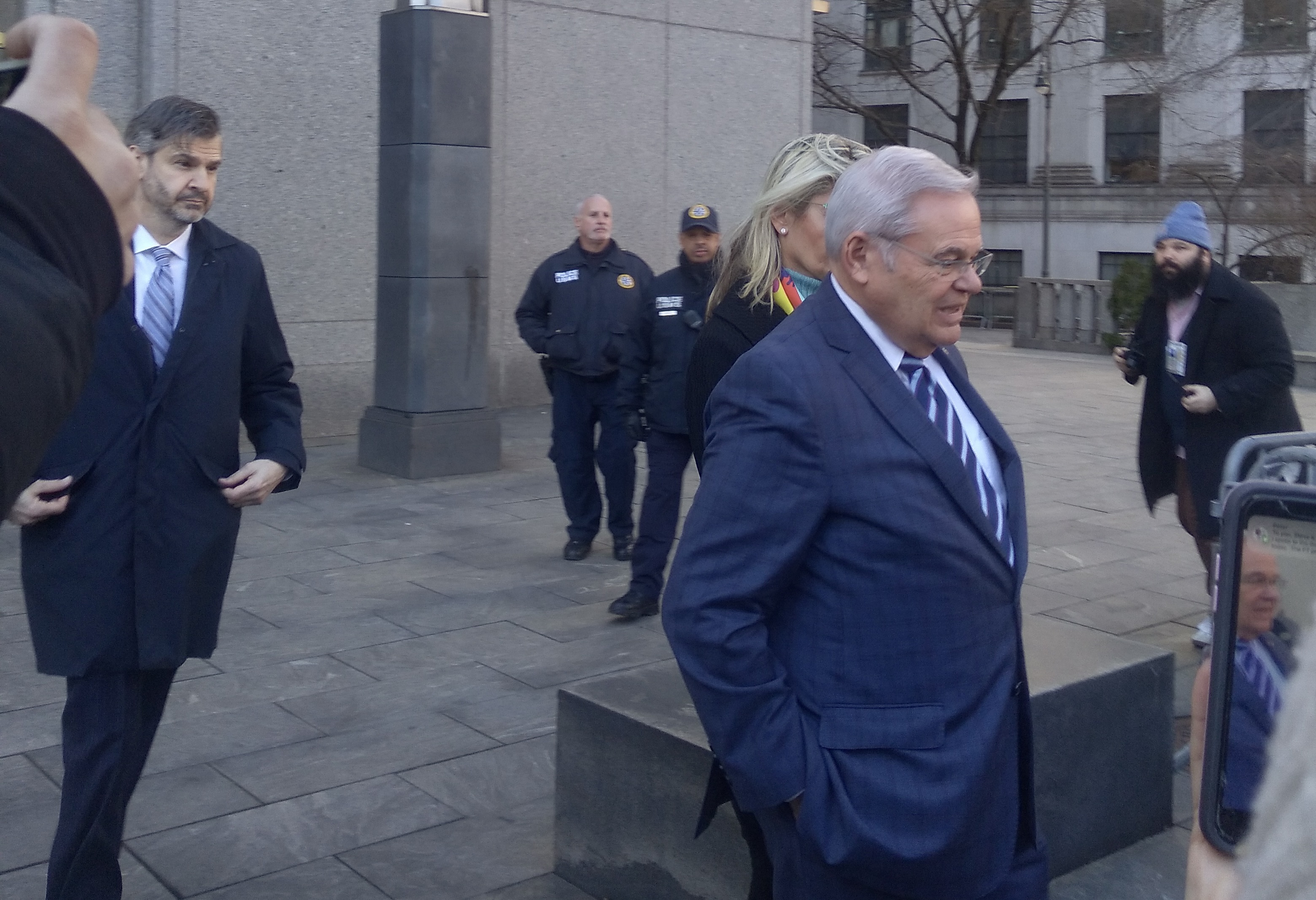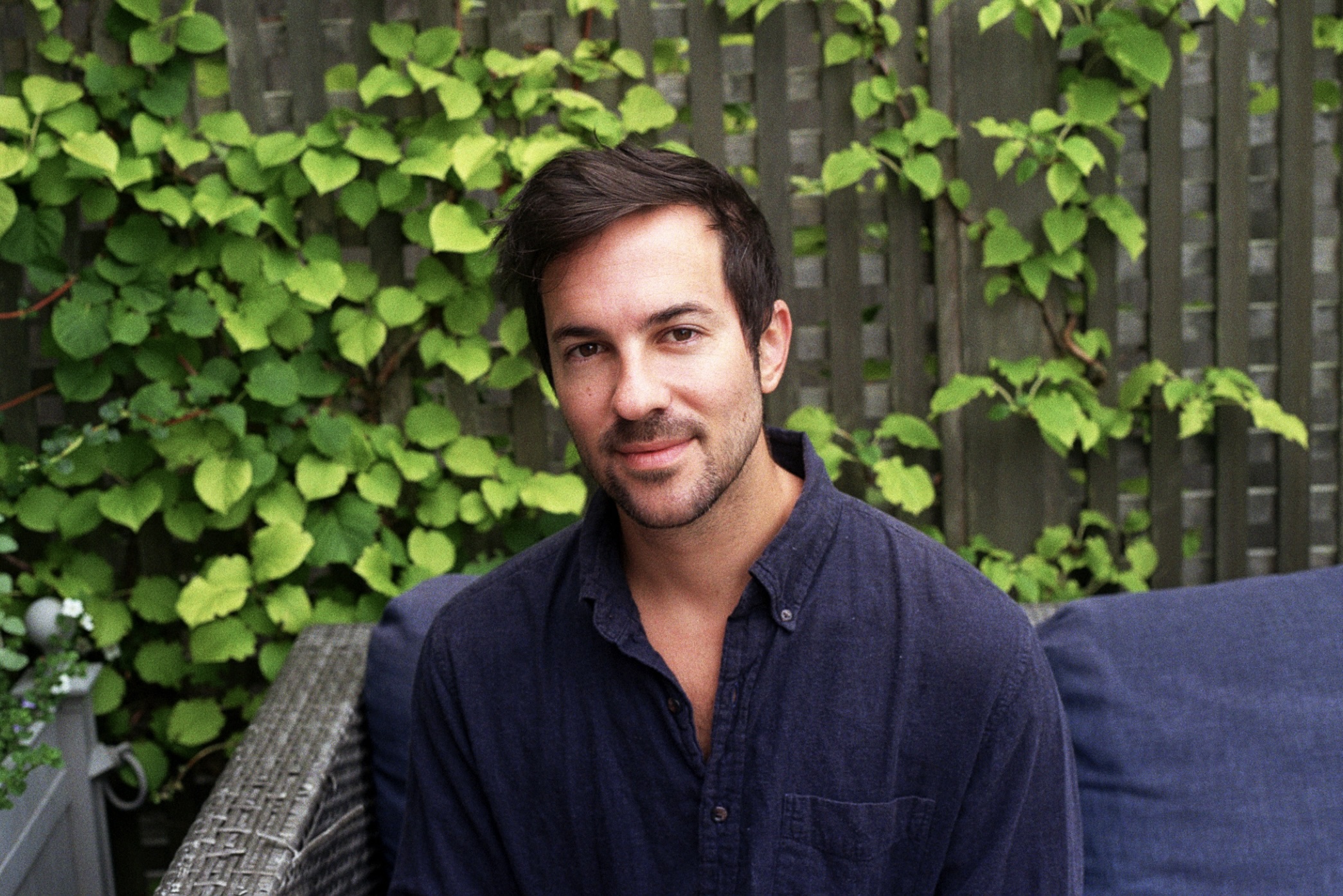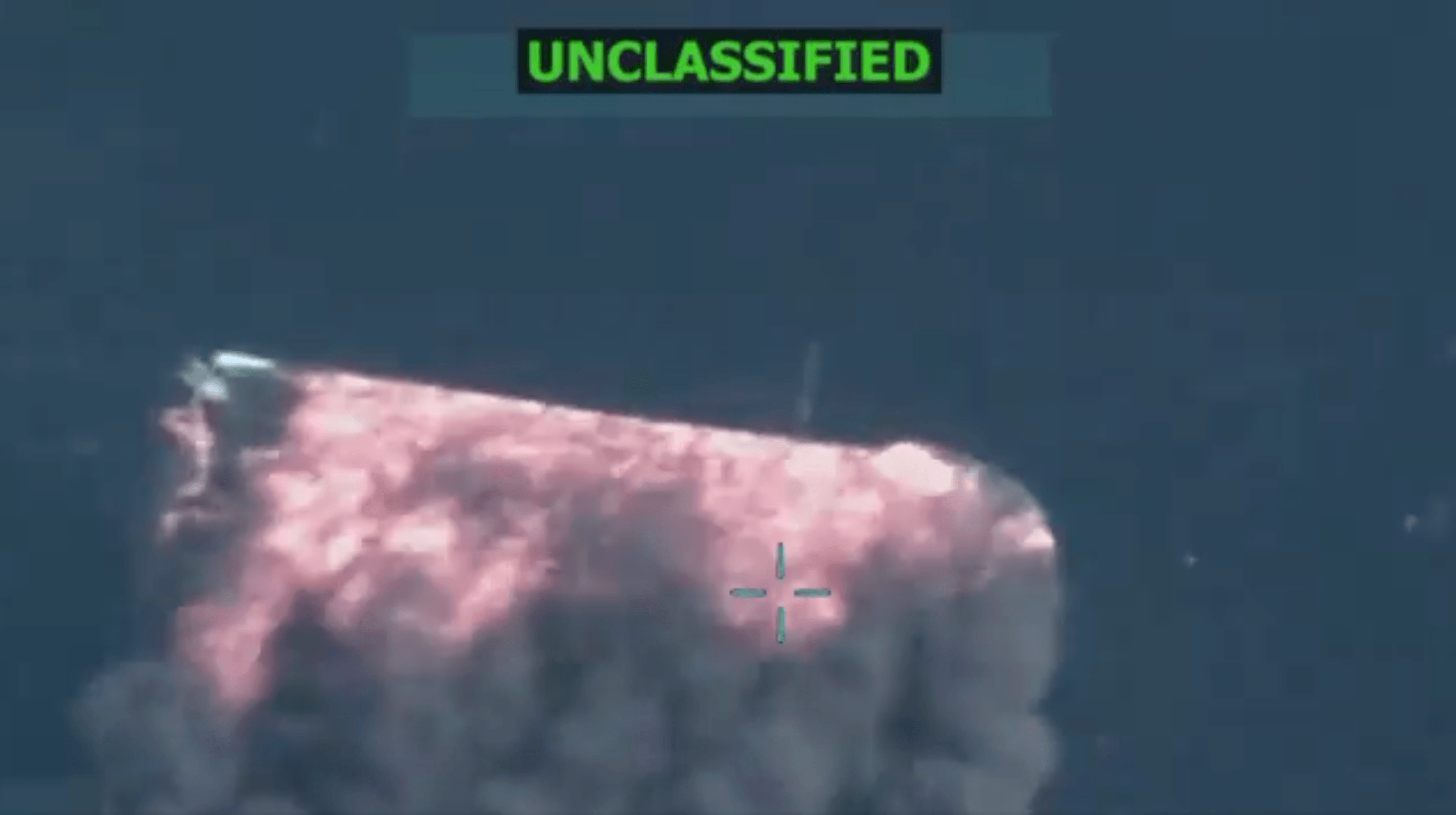“Once again, not guilty, your honor”: Menendez Supersedingly Arraigned in Federal Court
A dispatch from the courtroom of U.S. District Judge Sidney H. Stein.

Published by The Lawfare Institute
in Cooperation With

It’s 9:30 a.m. on the 23 floor of the Daniel Patrick Moynihan Courthouse, home to the U.S. District Court for the Southern District of New York.
I’m sitting on a long wooden bench outside of Courtroom 23A. The walls are made of a beautiful white marble. Outside the window behind me, it’s a clear, crisp morning, and I can see the Brooklyn Bridge stretching into the neighboring borough.
On the bench beside me, two courtroom sketch artists talk shop.
Clearly, they have done this before. And by “this,” I don’t mean courtroom sketches in general—the two artists seem to be veterans of their craft. I mean they’ve literally done this before: sketching the arraignment of Sen. Robert Menendez (D-N.J.) on federal bribery charges.
“He showed up with his wife last time, right?” one artist recalls, referring to one of Menendez’s co-defendants, his wife Nadine Menendez. They continue to discuss logistics—seating arrangements, line-of-sight to the defendants, and the like—hatching plans to get a more advantageous seat in U.S. District Judge Sidney H. Stein’s courtroom this second time around.
By contrast, I am a newbie at covering arraignments of senators, much less repeated arraignments of Sen. Menendez.
Last September, the Justice Department unsealed its indictment charging Menendez, his wife, and three New Jersey businessmen—Wael Hana, Jose Uribe, and Fred Daibes—with federal bribery charges related to allegations that the senator used his “power and influence as a Senator to seek to protect and enrich Hana, Uribe, and Daibes, and benefit the Arab Republic of Egypt.” The salacious details contained in the indictment’s 39 pages—including nearly half a million dollars’ worth of cash stuffed in envelopes and a navy jacket sporting the senator’s name, over $100,000 worth of gold bars, and a luxury Mercedes-Benz parked in the Menendez driveway—made for riveting reading.
On Sept. 27, Sen. Menendez pleaded not guilty on all counts. But I wasn’t there.
Nor was I there for the encore performance in October. For anyone who missed the chance to watch the arraignment of a sitting U.S. senator, the show was back by popular demand with additional charges just a few weeks later. On Oct. 12, federal prosecutors issued a superseding indictment accusing Sen. Menendez, Nadine Menendez, and Hana of conspiring to have the senator act as an agent of the Egyptian government, as he served as chairman of the Senate Foreign Relations Committee, without registering with the Justice Department.
On Oct. 23, Sen. Menendez pleaded not guilty on all counts—again. And once again, unlike the sketch artists, I missed the show.
But the third time’s the charm. So when the government announced yet another superseding indictment on Jan. 2, adding charges that Sen. Menendez had also used his political influence to aid the government of Qatar, and when yet more charges came on March 5, as prosecutors added obstruction of justice charges—thus increasing the number of charges from four to 18 against Sen. Menendez and his wife—I wasn’t going to swing and miss a third time.
The spree of superseding indictments was likely less welcome news to Sen. Menendez and his co-defendants than it was to those of us who had missed the prior arraignments and for whom arraignment of a sitting senator is a kind of bucket-list item.
The defendants enter Courtroom 23A at 10:50 a.m., just 10 minutes before the third arraignment in six months is set to begin.
The senator takes his seat and stares forward, his fingers steepled in front of him, as the sketch artists—now seated directly in front of me, their sight-lines secured—pull out small binoculars to get a better look at their subjects.
“All rise,” says the deputy clerk at exactly 11:00 a.m., as Judge Stein walks up to the bench and takes a seat under a large district court seal.
“Counsel, please state your names for the record,” the clerk continues.
Paul Monteleoni rises for the government and introduces his colleagues Eli Mark, Lara Pomerantz, and Daniel Richenthal.
Next, Adam Fee, counsel for Menendez, rises and introduces his partner Avi Weitzman.
“Good morning,” Judge Stein greets them. “Mr. Menendez is present as well, the record should note.”
The process repeats for Danny Onorato, on behalf of Nadine Menendez, and Lawrence Lustberg, along with his colleagues Ricardo Solano and Anne Collart, on behalf of Wael Hana.
“Please be seated,” Judge Stein says, prematurely.
A lawyer seated in the second row of defendants rises quickly and says, “One more, your honor.” In Judge Stein’s defense, the defendants and their respective defense teams make up quite the crowd, and I imagine it’s difficult to see everyone at once unimpeded—the judge having less choice about his seating, and therefore his sight-lines, than the sketch artists. The sketch artists, I’m confident, are similarly understanding.
The left-out lawyer, Cesar de Castro, had risen with his colleague Shannon McManus, both on behalf of Fred Daibes. He now introduces himself quietly before sitting back down.
Judge Stein moves on to the reason we’re all here: the arraignment of each of the defendants. Beginning once again with the senator, the judge asks the defendants one by one to state their full names, asks whether they have any questions about the latest superseding indictment (referred to as S4), and if they care to have the indictment read aloud in the courtroom, a right they all mysteriously waive. The judge also asks each defendant to enter a plea. It’s not guilty across the board.
With the arraignment formalities now behind us, Stein moves to the second order of business, a “point of information for counsel” regarding the classified information security officer, who voiced in an email to the judge his disappointment that only two members of the defense teams scheduled a briefing with him. As Stein explains, the classified information security officer will explain how counsel who are cleared to receive the trial’s sensitive classified materials will work within the “SCIF” (which stands for “sensitive compartmented information facility” and is pronounced “skiff”).
“The classified information is going to be produced—or at least some of it, I understand—shortly,” Stein explains. “So please get those clearances and attend that briefing because you can’t receive classified information without that.”
The room remains quiet, and Stein takes a deep breath. I use the elongated pause to admire the courtroom’s mahogany walls and royal blue carpeting. My gaze returns to Sen. Menendez, whose fingers have returned to their steepled position in front of him once again.
“Now let’s go to the schedule,” Judge Stein says without animation. “This is what I’m going to do: I am keeping the May 6 date.”
The judge has denied request for an adjournment and adds that he will issue a ruling shortly on the Speech or Debate Clause and separation of powers issues raised by the defense. In January, Menendez asked the judge to dismiss the bribery and foreign agent charges for two reasons: because the U.S. Constitution’s Speech or Debate Clause shielded him from prosecution, and because McDonnell v. United States, a 2016 Supreme Court decision, excluded the senator’s actions from the bribery statute’s definition of “official act.”
Another deep breath. Another long pause.
Stein then explains that, although he thinks the May 6 trial date is firm, he will not require the 3500 material—written statements and reports of the government’s witnesses—be turned over until it’s really firm, a moment that will come when there’s no longer the possibility of the Second Circuit granting a stay of trial pending adjudication of an interlocutory appeal that may not even happen.
Pending that unlikely course of action, the judge rattles off the schedule. April 5, motions in limine, proposed jury charges, proposed voir dire are all due. One week later, on April 12, responses to any motions in limine will be due. April 15, production of 3500 material, government witness lists, government exhibit lists. The final pretrial conference will be held on April 30, followed by the commencement of the trial, one week after that, on May 6 at 9:30 a.m.
Stein then asks each side how long they estimate they will need for their respective cases. Monteleoni thinks the government will need about four to six weeks, “subject to all the usual caveats,” and Fee, speaking for the defendants, estimates with some difficulty that the defense case will require at least a week.
Having dispatched with the scheduling particulars, Stein asks what the parties are thinking in terms of expert testimony. A few reporters in the gallery perk up at this question.
“Your honor, we anticipate noticing certain experts,” Monteleoni replies.
“What are ‘certain experts’?” Stein asks, not content with the government’s vague response.
Monteleoni, with his usual caveats, mentions a DNA expert, a fingerprint expert, and a cell site and other location information expert. The defense attorneys, for their parts, do not anticipate the need to call experts at this time.
Turning now to the question of motions addressed specifically to S4—the latest superseding indictment—Stein asks Fee to get him those motions two weeks from today, with one week for response. But with several superseding indictments over the past few months, things get a little hairy. Because a number of motions under S2 still need to be decided, Stein wonders aloud whether the most efficient way to proceed would be to dismiss the pending motions, in order for parties to file a new set of motions addressed to S4.
“That makes sense,” says Fee. “And obviously the Court can handle the docketing of the motion as it wishes. I think our intention is to be as lean and mean as possible with the supplement.”
“You’re trying something new,” Stein quips, winning the first laughter of the short arraignment hearing.
“A new day dawns, your honor,” Fee responds in jest. “And I’m sure the Court wasn’t intending to suggest this, but there are some motions that aren’t directed necessarily to the substance of the indictment, like the venue and the severance motions, although venue would be separate. But severance would still persist in its current form.”
Stein makes clear that he understands this perfectly well, and moves to close the hearing, unless the parties would like to raise anything else.
Monteleoni rises with two brief points. First, he mentions that after the filing of the S4 indictment, the government believes that there may be a potential Curcio issue—a concern raised when a defendant’s counsel faces potential conflicts—with respect to one of the lawyers for the defense, but assures the judge that parties have been discussing it and hope to issue a joint proposed inquiry soon.
Second, Monteleoni points out that “the time has obviously been excluded on the underlying and the S1 indictments” and moves for the exclusion of the time on the S4 indictment until the beginning of the trial on May 6, under the Speedy Trial Act in the interest of justice. Hearing that each counsel for the defendants would join in that submission, Stein grants the motion.
Not even 20 minutes have passed, and it seems like that’s a wrap on the third arraignment of Sen. Menendez—until Fee rises for a “brief clarification,” if he may. Fee returns to Stein’s imminent decision on the speech or debate and separation of powers issue: “So I think we may need to address this with the supplemental filing, because obviously those motions were directed to the S2 indictment, the speech and debate we now have—,” but Stein cuts him off.
“But there’s nothing additional on speech and debate in S4, to my knowledge, or separation of powers,” Judge Stein replies.
After some back and forth, the judge tires of “going round and round,” and, failing to see how any supplement could impact or change a decision on speech or debate or separation of powers, poses a final question to Fee: “Am I wrong?”
“You’re never wrong, your honor,” Fee replies cheekily, winning the day’s second round of laughter.
“All rise,” the clerk announces at 11:20 a.m. And I marvel at what the sketch artists had managed to accomplish in such a short time.
Once Judge Stein disappears into his chambers, the parties begin to shuffle out.
Out in the hallway, a small gaggle of reporters pose a few questions, all related to whether he plans to run for reelection, to Sen. Menendez as he waits for the elevator.
“I wouldn’t be announcing it in a courtroom,” the senator jokes while walking into the elevator.
“Well, this technically isn’t a courtroom,” another reporter quips, but the senator doesn’t hear the point. The elevator doors have already closed.
With a trial less than two months away, if he does want to make such an announcement in a courtroom, the senator will have ample opportunity to do so.
In the meantime, I can check senatorial arraignment off the bucket list.


.jpg?sfvrsn=8253205e_5)


